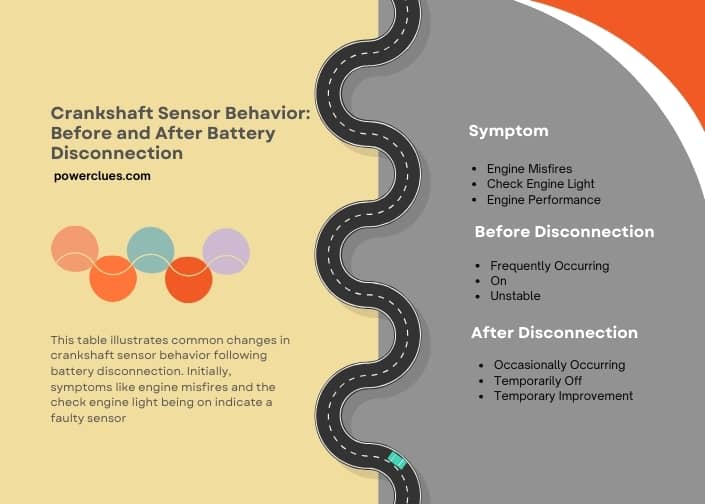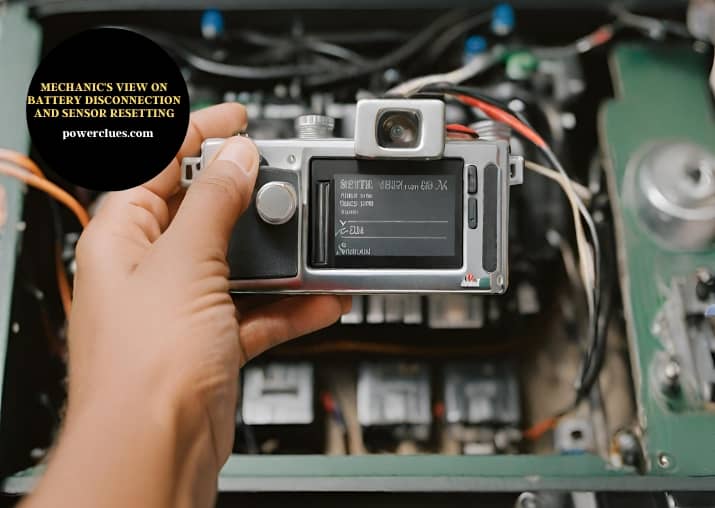Resetting Crankshaft Sensor: Battery Disconnection Effects
Disconnecting the battery can reset the crankshaft sensor in some vehicles. This process clears stored error codes and recalibrates the sensor.
In modern vehicles, the crankshaft sensor plays a vital role in engine management. It monitors the position and rotational speed of the crankshaft, sending data to the vehicle’s computer system. This information is crucial for controlling fuel injection and ignition timing. When a crankshaft sensor malfunctions, it can lead to issues like erratic engine performance, difficulty in starting the engine, and unexpected stalling.
Resetting the crankshaft sensor by disconnecting the battery is a common practice among vehicle owners and mechanics. This action can temporarily clear any error codes related to the sensor, potentially improving the vehicle’s performance.
It’s important to note that this method does not fix mechanical faults within the sensor itself. If the sensor is physically damaged or has deteriorated over time, disconnecting the battery will not resolve these issues.
After reconnecting the battery, it’s advisable to let the engine idle for a few minutes. This allows the vehicle’s computer to relearn and recalibrate its settings. If the problems persist, it indicates a deeper issue with the crankshaft sensor or other related components, necessitating a professional diagnostic and potential replacement of the sensor.
Battery Disconnection and Crankshaft Sensor Functionality
Disconnecting a car battery can have significant effects on the crankshaft sensor. This sensor plays a crucial role in monitoring the position and rotational speed of the crankshaft, which is vital for engine management. Disconnecting the battery might reset error codes, including those related to the crankshaft sensor.
This action can also lead to the loss of essential calibration data. When the battery is reconnected, the vehicle’s electronic control unit (ECU) may initiate a reinitialization process. This process can recalibrate the sensor, but it’s not guaranteed to resolve underlying mechanical issues. It’s essential to understand that while disconnecting the battery can temporarily clear error codes, it doesn’t fix mechanical faults in the sensor itself.
Safe Battery Disconnection and Reconnection
Handling a car battery requires specific steps to ensure safety and avoid damage to the vehicle’s electrical system. Before starting, gather necessary tools like wrenches and safety gear. Identify the negative and positive terminals of the battery. Always disconnect the negative terminal first to prevent short circuits.
After completing the required work, reconnect the battery by attaching the positive terminal first, followed by the negative. This sequence minimizes the risk of sparking and potential damage. It’s crucial to follow these steps meticulously to maintain the integrity of the vehicle’s electrical system, including sensitive components like the crankshaft sensor.
Crankshaft Sensor Behavior: Before and After Battery Disconnection
| Symptom | Before Disconnection | After Disconnection |
| Engine Misfires | Frequently Occurring | Occasionally Occurring |
| Check Engine Light | On | Temporarily Off |
| Engine Performance | Unstable | Temporary Improvement |
This table illustrates common changes in crankshaft sensor behavior following battery disconnection. Initially, symptoms like engine misfires and the check engine light being on indicate a faulty sensor. After disconnecting and reconnecting the battery, there might be a temporary improvement in performance. These changes are often short-lived, as the underlying sensor issue remains unresolved.

Battery’s Role in Electronic Systems and Sensor Operations
The car battery is integral to the operation of electronic systems, including sensors. A healthy battery ensures accurate readings from sensors like the crankshaft sensor. Conversely, a failing battery can lead to erratic sensor behavior and false readings.
| Battery Health | Sensor Accuracy |
| Good | High Accuracy |
| Poor | Low Accuracy |
This table shows the correlation between battery health and sensor performance. Maintaining battery health is crucial for the overall performance of the vehicle’s electronic systems.
Mechanic’s View on Battery Disconnection and Sensor Resetting
Automotive professionals often have mixed opinions about the effectiveness of battery disconnection for resetting sensors like the crankshaft sensor. While it can clear error codes, it’s not a substitute for proper diagnostic and repair procedures. Mechanics caution against relying solely on this method for long-term solutions.
They emphasize the importance of addressing the root cause of sensor issues. Anecdotal evidence from mechanics suggests that while battery disconnection can be a useful diagnostic tool, it should not replace comprehensive mechanical inspection and repair.

FAQs
Can Disconnecting the Battery Affect Other Sensors Besides the Crankshaft Sensor?
Disconnecting the battery can indeed influence other vehicle sensors. The action resets the vehicle’s electronic control unit (ECU), affecting sensors related to the engine, transmission, and sometimes the airbag system. This reset can temporarily clear stored error codes and recalibrate sensor readings.
It’s not a cure-all solution. Some sensors might require manual recalibration or specific diagnostic procedures to function correctly after the battery is reconnected. It’s essential to be aware that while disconnecting the battery can reset some settings, it might not resolve underlying issues with various sensors.
Is It Safe to Disconnect the Battery to Reset the Crankshaft Sensor?
Safety is a primary concern when disconnecting a car battery. It is generally safe to disconnect the battery for a short period to reset the crankshaft sensor, but certain precautions are necessary. Always turn off the vehicle and ensure it’s in a safe, stationary position. Use appropriate tools and wear protective gear to prevent accidents.
Remember that disconnecting the battery can erase stored data in the vehicle’s computer system, so it’s advisable to consult a professional or refer to the vehicle’s manual before proceeding.
What Are the Signs That the Crankshaft Sensor Needs Resetting?
Identifying the need to reset the crankshaft sensor involves recognizing specific symptoms. These include erratic engine behavior, such as sudden stalling, difficulty starting the engine, poor fuel economy, and a loss of power.
The check engine light may also illuminate as a direct indication of issues with the crankshaft sensor. If these symptoms are present, resetting the sensor by disconnecting the battery might be a temporary solution, but it’s crucial to address the root cause of the problem for a long-term fix.
Does Disconnecting the Battery Reset All Vehicle Codes?
Disconnecting the battery can reset most of the stored codes in a vehicle’s computer system. This includes check engine lights and error codes related to various sensors, including the crankshaft sensor.
Not all codes are cleared by this method. Some hard codes, particularly those related to serious issues or safety systems like airbags, may require a professional diagnostic tool to reset. It’s also worth noting that disconnecting the battery will not fix the underlying issues causing these codes.
How Long Should the Battery Be Disconnected to Reset the Sensor?
The duration for disconnecting the battery to reset the crankshaft sensor varies, but a general guideline is to disconnect it for about 10 to 15 minutes. This time frame allows the vehicle’s electronic systems to fully reset.
The exact time can depend on the vehicle model and the specific nature of the sensor issue. In some cases, a shorter or longer period might be necessary. Always refer to the vehicle’s manual or consult a professional mechanic for the best practice specific to your vehicle.
What Should Be Done After Reconnecting the Battery?
After reconnecting the battery, there are several steps to ensure the vehicle’s systems function correctly. Start the engine and let it idle for a few minutes. This allows the ECU to recalibrate and adjust to the cleared codes.
Check for any warning lights on the dashboard. If they reappear, it indicates that the issue wasn’t resolved by resetting. It’s also advisable to take a short test drive to ensure that the vehicle is operating smoothly and that all sensors, including the crankshaft sensor, are functioning correctly. If any issues persist, a professional diagnostic may be necessary.
Summary
In summary, disconnecting a car battery can impact the crankshaft sensor in various ways, from resetting error codes to causing data loss. While it’s a common practice for temporary fixes, it’s not a definitive solution for sensor issues. Safe battery handling is crucial for vehicle maintenance, and understanding the relationship between the battery and vehicle electronics is key. Professional insights underline the importance of proper diagnostics and repairs over quick fixes like battery disconnection.
